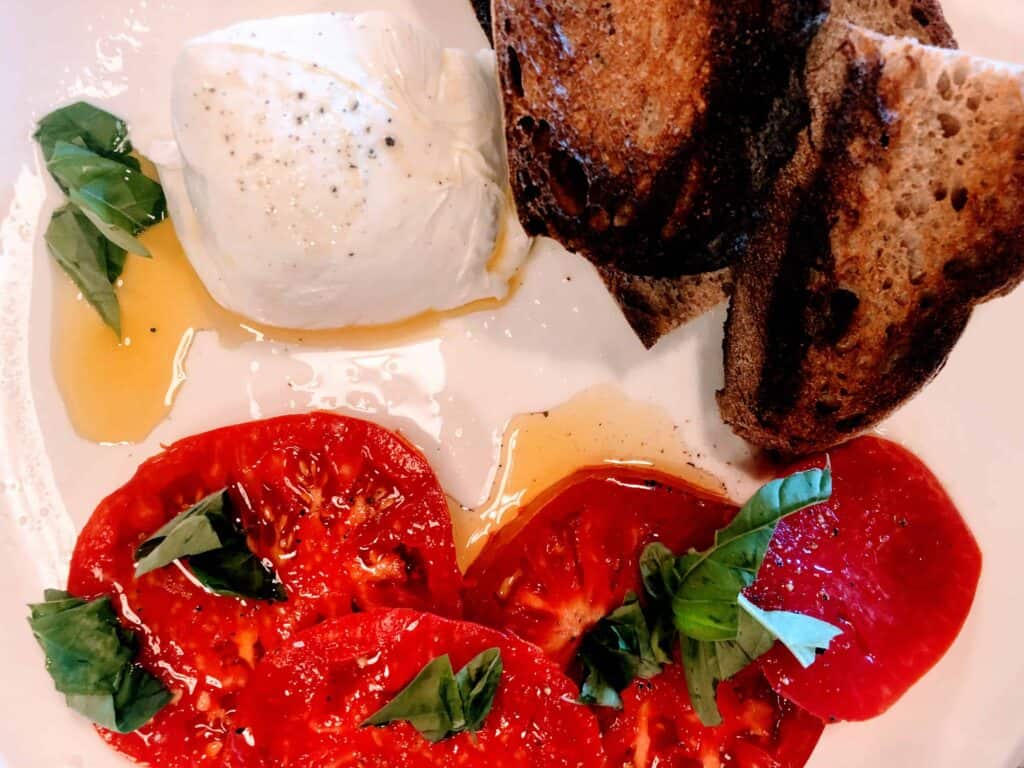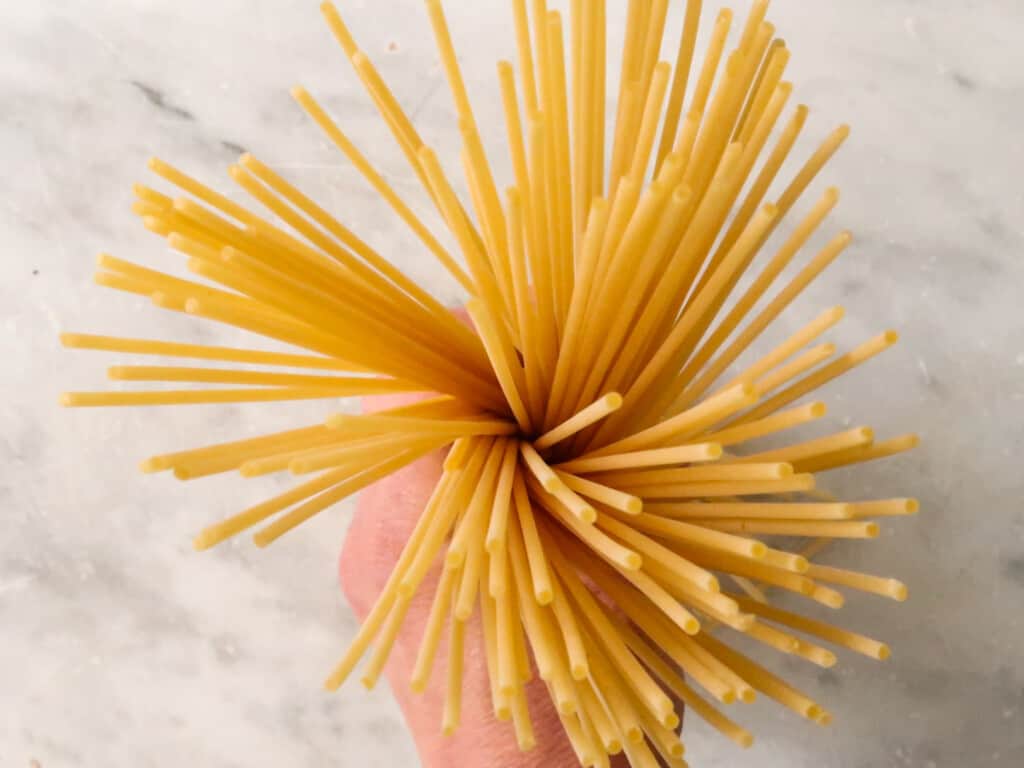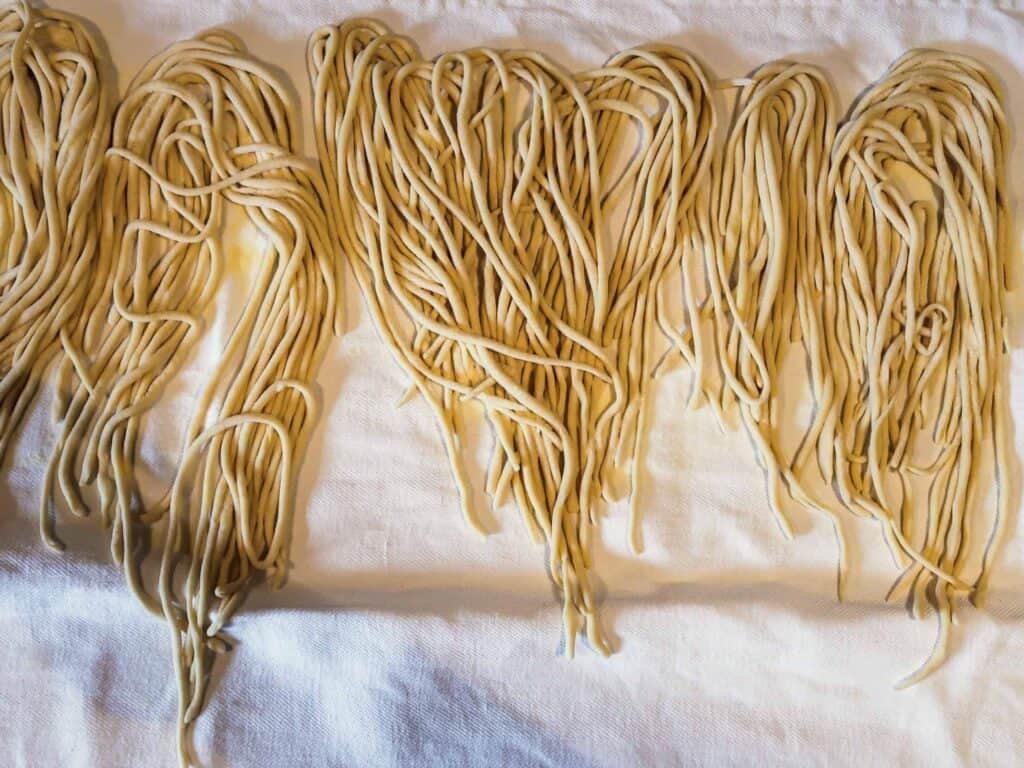Last updated on March 6th, 2024
Are you looking for the best ways to peel garlic?
Maybe you need a ton of it for your recipe but don’t want to end up with smelly hands.
Even if you only need a clove or two, you may be wondering what the easiest and most effective way to peel garlic is.
You are not alone! Garlic is one of the most common ingredients across cultures and you will most likely be using it everyday if you are a home cook. In Italy we use a ton of garlic, all different kinds, so at this point, peeling it is just part of my daily routine.
In this article, I will share with you my favorite ways to effectively peel garlic quickly, share the pros and cons of each garlic-peeling method, and also share other common garlic-peeling techniques.

In addition, I will cover:
- The different kinds of garlic
- How to choose and store garlic
- How to separate garlic cloves from the head
- How Italians use garlic
- Tools for peeling garlic
- Recipes for using garlic
- How to remove the garlic smell from your hands
- How to chop garlic
Jump to Section
Purple Garlic vs White Garlic

White garlic, also known as the softneck variety, is the most common garlic you will find in the US. The garlic stalk does not grow directly through the center of the bulb but will be held together by smaller cloves in the center of different shapes and sizes. Larger cloves then enclose these in a second layer. White garlic is a very resistant and hardy variety of garlic.

Purple garlic, or the hardneck variety, is made up of the same color garlic cloves as white garlic but it has a slight purple color to the outer skin. In this variety, a woody stalk grows through the center of the bulb and the uniform cloves grow around it.
Purple garlic cloves have a slightly milder flavor than their white counterparts.
Fact: While purple garlic is harder to come by in the US, it’s the preferred variety in Italy.
Substituting Garlic Purple And White Garlic

Purple and white garlic can be used interchangeably. I recommend using purple garlic for things like salad dressings or making fettunta because when it’s raw, the subtle flavor of purple garlic is more palatable.
What Is Elephant Garlic?

This enormous head of garlic, known as aglione in Italian is a common ingredient here in Tuscany but it’s actually more similar to a leek than garlic. Although shaped in the same way and still part of the allium family, the actual cloves of elephant garlic are milder than garlic cloves, similar to how leeks are milder than onions.
Tastes Like: Elephant garlic has the same flavor profile as garlic but it can actually taste a bit sweet. You can even eat it raw in salads!
White and purple garlic variety heads have around 10-12 (and up to 20!) cloves but an elephant garlic clove, anywhere from 2-4 times larger, only has 6-8 cloves of garlic. The flesh of the garlic cloves has a slight yellow color, compared to the crisp white of normal garlic.
Substituting Elephant Garlic For Regular Garlic
You can use elephant garlic in place of white or purple garlic in equal proportions but the flavor will be much more mild. This isn’t necessarily a bad thing though and is actually the primary reason Tuscans love it. It doesn’t necessarily overpower other ingredients and they say it’s easier on digestion.
Make It: Use elephant garlic to make aglione sauce.
How To Choose Garlic

Most supermarkets will carry the white variety of garlic. If you are looking for purple or elephant garlic, head to farmers markets or specialty grocery stores.
Fresh garlic is harvested between June and August, depending on where you are in the US so if you would like to try using fresh garlic, keep your eyes peeled in the Summer.
When choosing garlic:
- Look for bulbs that are firm, privy of any brown spots
- Avoid shriveled, dry looking bulbs. The outer skin should not be flaking off too much (indication of old age)
- Avoid soft or mushy heads of garlic.
- Avoid garlic that has started to sprout
- Avoid garlic that stinks
How To Store Garlic
Your method of storage will depend on whether the garlic has been peeled or not.
How to Store Unpeeled Garlic
Store garlic in a cool, dry place away from other ingredients that might take on their odor such as onions. They should have good air circulation so choose a holding vessel such as a basket to store the garlic.
Cool cellars or garages are ideal locations for storing garlic.
Never refrigerate whole heads of garlic because they won’t last long.
How To Store Peeled Garlic

Peeled garlic can be stored in the refrigerator in an airtight container for up to five days. Inspect for mold or any bad smell before using.
How To Store Minced Garlic
You can easily store minced garlic in the refrigerator to ease weeknight cooking. Chop or mince garlic using your preferred method. Store in an airtight container, covered with a thin layer of olive oil to help keep it longer. The oil slows down any oxidation and decomposition of the minced garlic.
Freezing Peeled Garlic
You can absolutely store garlic by freezing it. Spread garlic cloves on a baking sheet and freeze for about 1 hour. Pop the frozen cloves into a ziplock bag or other airtight container for up to 6 months.
Tip: Double bag garlic as its aroma can be absorbed by other things in the freezer over time!
You can also grate, mince or slice your garlic and freeze this way. If you freeze it in a thin layer until hard, you can then bag it up and break off a piece of ‘garlic paper’ whenever you need it!
Good To Know: Although freezing garlic won’t compromise its flavor, it does slightly change its texture.
How To Separate Garlic Cloves From Head
No matter how you end up peeling your garlic, you will need to separate the cloves from the head without damaging the individual cloves.

Place the garlic on your cutting board, root side up, and use both palms of your hand to push down firmly. The bulb should just crack open and the cloves can easily be separated at this point.
How To Easily Peel Garlic With A Knife

Best For: When you just need a few cloves of peeled garlic but don’t need a whole head.
Peeling garlic with a large kitchen knife is the most traditional way to peel garlic and my personal favorite.

After removing the garlic clove from its head, place it on the cutting board. Place the flat part of a wide kitchen knife over it, pressing down firmly but with gentle pressure to avoid smashing the entire clove. You will hear the skin making a crunching noise as it starts to break open. That’s it! Remove the knife and peel the garlic peel away.
If you accidentally crush the garlic in the process, it’s fine if you plan on chopping or mincing the garlic. If you are adding the garlic to a pot and removing it later for a more subtle flavor, it can fall apart easily and be hard to fish out late (many Italians like this crushed method because it helps extract the garlic aroma from the clove).
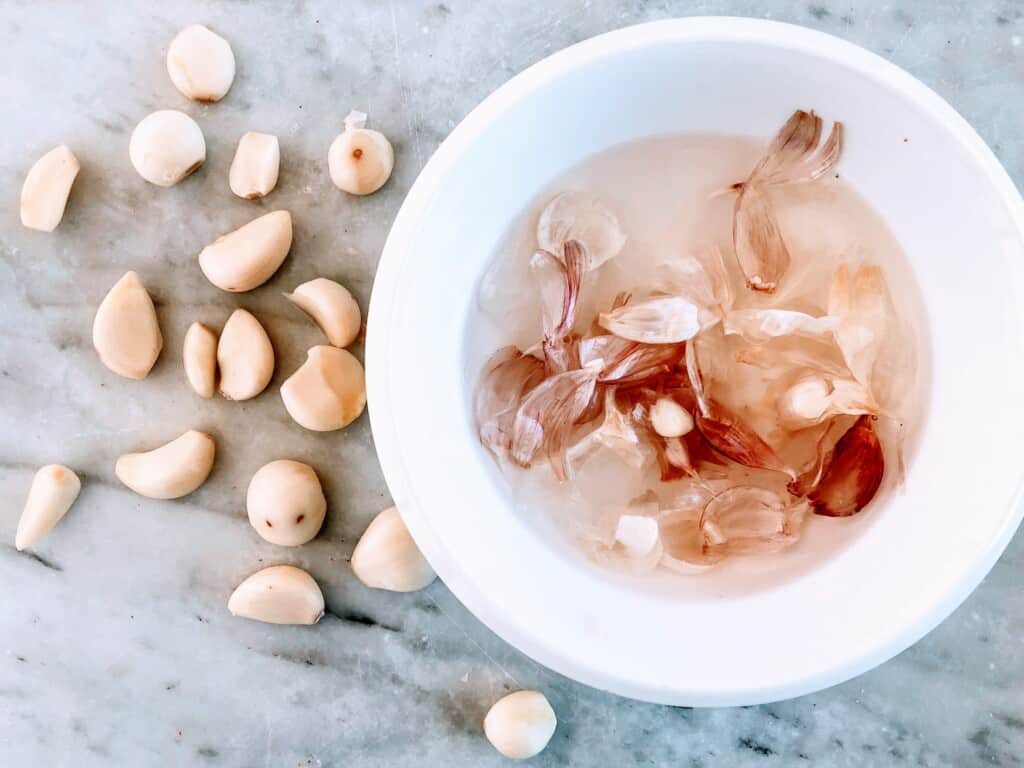
Tip: Peeling garlic with a kitchen knife works even better if you cut off the tiny root end at the bottom of each clove.
How To Easily Peel Garlic With Hot Water
Best For: Large quantities of garlic and when you would like to keep the cloves fully intact.
I have had great success with this method. Not only is it easy and quick but it also maintains the presentation of the whole clove.
Fact: Soaking the garlic cloves in hot water is similar to blanching nuts to remove their skins. The hot water does not actually cook the garlic.
Remove the garlic cloves from its head and place them in a bowl (avoid plastic). Pour over boiling water and let them soak for about 1 minute. Remove one clove and peel back the peel. If it doesn’t easily come off, leave the garlic for another 30 seconds.

Tip: Leave the garlic cloves in the water and peel one at a time, allowing cloves that need a little extra soaking time to sit in the hot water while you work.
How To Easily Peel Garlic In The Microwave
Best For: Peeling a large amount of garlic that you would like to keep whole.
Peeling garlic in the microwave can be effective but you do risk slightly cooking the garlic if you microwave for too long (the time will depend on your microwave, temperature of water, amount of garlic and size of garlic cloves).
Method I – Microwave Garlic Cloves

Remove the garlic cloves from the garlic head and place in a microwave safe bowl. Cover with water and microwave for 30-60 seconds. I recommend testing at 30 seconds and then adding more time if need be. This works ok for me, sometimes better than others.
One at a time, remove the skins manually by slipping them off of the garlic cloves.
Method II – Microwave Whole Garlic Head

Wrap the entire garlic head with a damp paper towel (not soaking wet) and microwave for about 15-25 seconds. I suggest checking at 15 seconds. Remove the garlic bulb from the microwave, rub the head with the damp paper towel and ecco fatto, the skins should slip right off! This is one of my favorite methods!
Tip: You want the garlic to be just warm, not hot in any way as you risk cooking it.
How To Peel Garlic With A Jar

Best For: Large quantities of garlic and when you would like to keep the cloves fully intact.
Also known as the ‘shake method’, in this method, a large jar or large glass bowl is used to jostle the skins loose of the garlic cloves.
This isn’t my favorite method because my results are often dependent on the age of the garlic. The fresher and ‘tighter’ the garlic heads, the more stubborn the skins are and the force of shaking them isn’t quite enough to remove them completely. I end up having to get out my knife to help me out. This being said, many people swear by it so it’s worth trying.
Separate the cloves from the head and place the unpeeled garlic cloves in a large glass bowl (I like a big tupperware container). You will want to choose something that is significantly larger than the amount of garlic you are adding.
Cover with either a lid or a plate turned upside down onto the bowl and holding them tightly together, shake vigorously for about 30 seconds. Remove the lid and you should see the skins hanging off the garlic. Manually remove any remaining garlic peels that are still clinging to the garlic cloves.
Nice To Know: Shaking the garlic like this does slightly ‘bruise’ the garlic cloves but it shouldn’t impact the flavor.

Other Methods Of Peeling Garlic
Cutting The Garlic Head In Half
Best For: When you plan on chopping or mincing large quantities of garlic.
Simply slice the garlic head in half right through the middle of the clove (horizontally through the clove, not vertically from root to top of the clove). Place the flat, cut-side down on a cutting board and using a large kitchen knife, press down on the garlic firmly and with even pressure. The skins should come off but not as easily on the root end of the two halves.
Honestly, this method takes a bit of upper body strength and I often get more garlic ‘juice’ on my hands, which I don’t love. The cloves on the root end also don’t release as well which is why this is not my preferred method.
Italian Cooking With Unpeeled Garlic Cloves
In Italian home cooking, it’s not uncommon to use unpeeled garlic cloves when roasting. In many Italian dishes, garlic is added for aroma and flavor but not actually consumed. Rather, they are removed from the dish after cooking, adding just a light, aromatic undertone of garlic.
Tip: Be sure the garlic is clean and preferably organic before using unpeeled garlic.

Simply remove the garlic from the head and toss with whatever you are roasting such as potatoes or vegetables. You can also add unpeeled garlic cloves when you are baking things such as fish in paper or in the cavity of a whole chicken when roasting. When you are ready to serve, remove the garlic from the food to avoid accidentally eating one!
Italian Tradition: Many Italians maintain to have difficulty digesting large amounts of garlic which is the reason for removing it before serving the food.
Tools For Peeling Garlic Easily
Silicon Tube
The only tool I have ever tried for removing garlic is the silicon tube and I did have good results with it. Simply place a garlic clove in the tube and with a bit of pressure, press down and roll back and forth. Essentially, the skin just peels away by creating a bit of friction between the skin and the clove itself.
This method is effective but I am not a fan of kitchen gadgets that are mono use. If you have decent kitchen storage and love gadgets, then this is for you!
How To Remove Garlic Smell From Hands

We all know how good garlic tastes but the raw smell can leave an annoying, residual odor.
Stainless Steel Method
Wet your hands with water and rub them on the side of a stainless steel surface. For me, this is the side of my sink but you can also buy a small stainless steel stone to rub between your hands. This method works not only for garlic smells but for other pungent odors as well!
Lemon Juice Method
Wash your hands well with warm water and soap. Next, rub your hands with lemon juice and rinse with warm water.
How To Chop Garlic Cloves
No matter which method you choose, always trim off the hard ends or little root of the garlic cloves with a small knife before chopping.
Chop Garlic

Chopping garlic involves holding the garlic firmly in one hand and chopping it into small pieces but not finely, which is considered a mince.
Mince Garlic

Mincing garlic means to chop it very finely. This can be accomplished in the same manner as chopping garlic but then you can continue to chop your small garlic pile over and over until it’s chopped extremely fine (larger than a normal chop but not quite a paste which can be achieved by pressing or grating garlic).
Slice Garlic

With a very sharp kitchen knife, hold the garlic clove tightly with the tips of your fingers and slice as thinly as possible.

Grate Garlic

Grating garlic is best for when you want a smooth paste, privy of any texture (best for salad dressings). Use a microplane, hold the peeled clove of garlic and gently grate it over a cutting board. This is my preferred method of chopping garlic.
Press Garlic
Peel the garlic and press it into a garlic press for a paste. You can also do this directly with unpeeled garlic but it can sometimes clog the press and you end up squirting garlic juice into your eye!
Bonus: Smash Garlic
Smashing garlic isn’t actually a form of chopping but its a common practice in Italy. Smash the garlic clove to help release it’s juices and aroma with the back of a large kitchen knife. Add it to your recipe as is but remember to remove before serving.
Tips For Cooking With Garlic

- As a general rule, 1 clove of garlic equals ½ teaspoon of minced garlic.
- Cook garlic over low heat because it burns easily.
- When adding garlic to a soffritto or any other recipe involving sautéing it in oil or butter, only add it the last 2 minutes of cooking.
- Gently infuse olive oil with garlic or butter over low heat using whole cloves of garlic to add a light garlic aroma. Remove the garlic after 1-2 minutes.
- Cook with whole cloves and remove before serving for a subtle garlic flavor and for easy digestion.
Italian Recipes Using Peeled Garlic
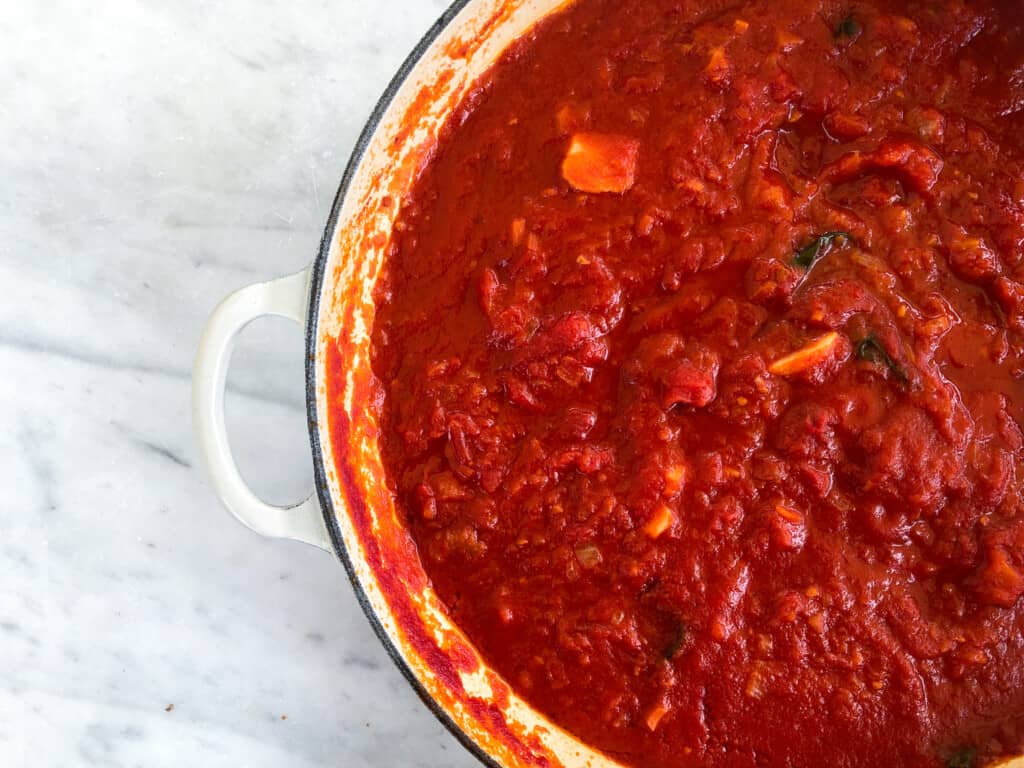
Italians use a lot of garlic but they often cook with the whole clove and remove it later, adding more subtle garlic flavor. Here are some of Italy’s most popular recipes using garlic:

- Pasta aglio, olio e peperoncino – pasta with garlic, oil and red pepper flakes
- Pici con aglione – hand rolled spaghetti with garlic tomato sauce (Tuscany)
- Patate arroste – roasted potatoes
- Fettunta – toasted bread with olive oil
- Bruschetta – toasted bread with fresh tomatoes and olive oil
- Soffritto – Italian base of cooked carrot, onion and celery for many dishes
- Pollo arrosto – roasted chicken
- Salsa verde – parsley green sauce
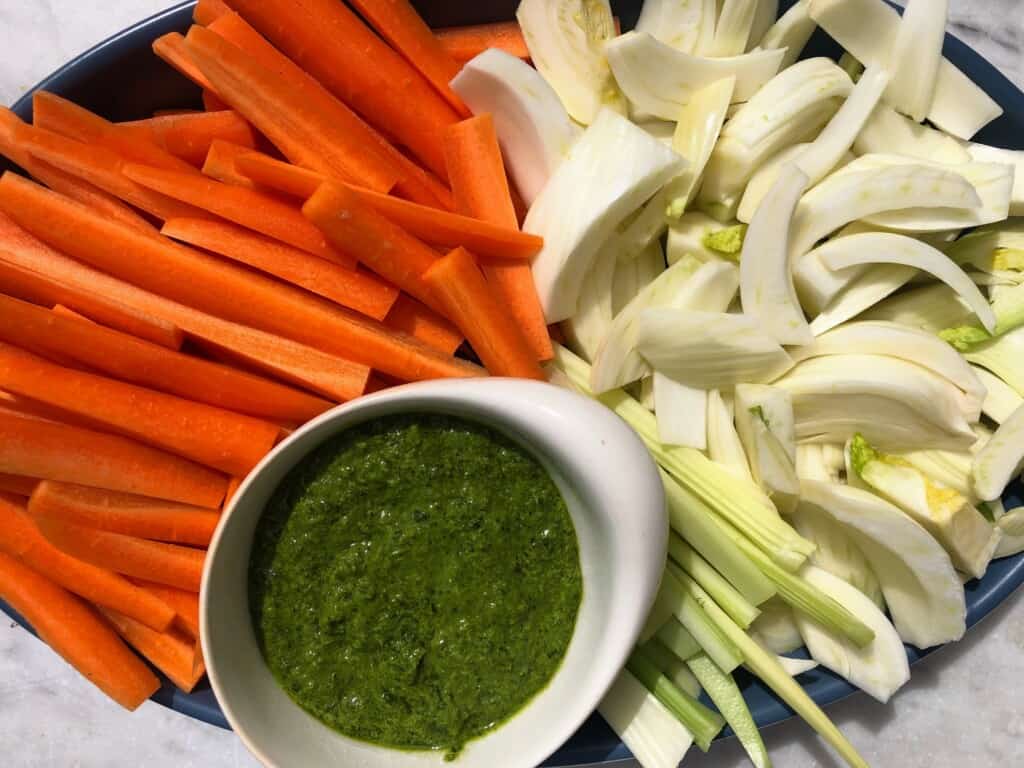
How To Peel Garlic FAQ
Yes, you can. Cover the chopped or minced garlic with a thin layer of olive oil to prevent decomposition and oxidation of the chopped garlic.
The most effective way to remove the garlic smell from your hands is to rinse them with water and rub them against a stainless steel surface such as your kitchen sink.
Yes, you can. Many Italians prefer this method because it facilitates digestion. Remove the whole garlic cloves before serving.
Yes, a silicon garlic tube works but a silicon mat rolled up will achieve the same results without having to buy an additional kitchen gadget.
If you keep garlic in an airtight container for up to 5 days.
You can either freeze individual cloves on a baking sheet and then transfer them to a ziplock bag or airtight container or freeze already minced garlic in small amounts.
The absolute best way to mince garlic is to grate it with a microplane. You will get the finest, smoothest paste without squirting juice everywhere.


